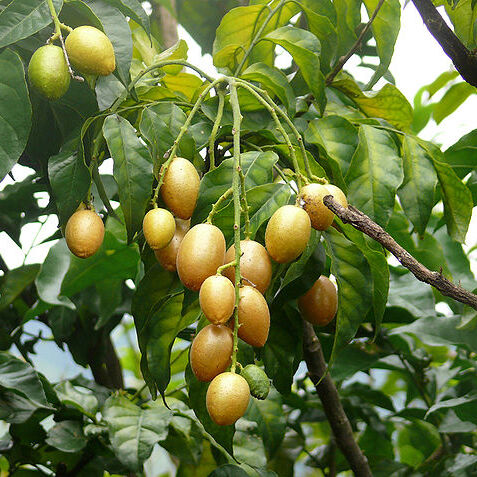Unarmed trees and shrubs. Leaves in spirals, imparipinnate; rachis rarely winged in mature plants; leaflets alternate, densely pellucid-dotted. Inflorescences terminal and/or axillary, thyrses or racemes. Flowers bisexual, rarely with some males, 4-and/or 5-merous. Sepals basally united, persistent. Petals free, imbricate, soon falling. Stamens 8 or 10 in 2 whorls, the outer (opposite sepals) often somewhat longer; filaments attached to disc; anthers dorsifixed, introrse. Disc annular. Gynophore hour-glass-shaped, glabrous. Ovary (2–) 4-or 5-locular, each locule with 2 pendulous, superposed to collateral ovules; style shorter than rest of pistil. Berry spherical to subconical, usually glandular. Seeds 1–3 (–5); cotyledons planoconvex.
Unarmed shrubs or trees. Leaves pinnate, alternate, densely dotted with pellucid glands, deciduous. Inflorescence a terminal or axillary panicle or lax raceme. Flowers bisexual. Sepals 4–5, united at the base, very small. Petals 4–5, free, imbricate in bud. Stamens 8–10, inserted at the base of the disk; filaments subulate, flattened towards the base; anthers elliptic, dorsifixed, introrse. Ovary stalked, (2–3–)4–5-locular, with 2 ovules in each locule; style short, caducous; stigma 2–5-lobed, broad, obtuse. Fruit fleshy, oblong, ovoid or globose, 2–5-locular. Seeds oblong.
Stamens 8–10, inserted at the base of the disk; filaments subulate, flattened towards the base; anthers elliptic, dorsifixed, introrse.
Ovary (2–3) 4–5-locular, with 2 ovules in each loculus; style short, caducous; stigma broad, obtuse, 2–5-lobed.
Leaves alternate, pinnate, densely dotted with pellucid glands.
Sepals 4–5, very small, united at the base.
Inflorescence of axillary cymose panicles.
Flowers small, 4-merous, bisexual.
Petals 4–5, imbricate in bud.
Fruit baccate, 1–2-seeded.
Unarmed trees or shrubs.

